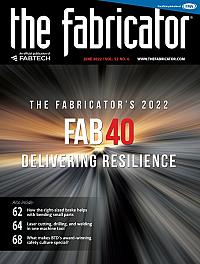Senior Editor
- FMA
- The Fabricator
- FABTECH
- Canadian Metalworking
Categories
- Additive Manufacturing
- Aluminum Welding
- Arc Welding
- Assembly and Joining
- Automation and Robotics
- Bending and Forming
- Consumables
- Cutting and Weld Prep
- Electric Vehicles
- En Español
- Finishing
- Hydroforming
- Laser Cutting
- Laser Welding
- Machining
- Manufacturing Software
- Materials Handling
- Metals/Materials
- Oxyfuel Cutting
- Plasma Cutting
- Power Tools
- Punching and Other Holemaking
- Roll Forming
- Safety
- Sawing
- Shearing
- Shop Management
- Testing and Measuring
- Tube and Pipe Fabrication
- Tube and Pipe Production
- Waterjet Cutting
Industry Directory
Webcasts
Podcasts
FAB 40
Advertise
Subscribe
Account Login
Search
How manufacturers scale with new tech, shifting demographics, market demand
It isn’t easy, which is why so few shops and companies do it in the metal fabrication industry
- By Tim Heston
- June 1, 2022
- Article
- Shop Management

Metal fabrication remains a business dominated by small shops, but new technologies, shifting demographics, and market demands are opening the door for more shops to grow. Getty Images
Nearly every June, when The FABRICATOR releases its FAB 40, I get a call from an analyst at an investment or market research firm asking why the custom fabrication industry hasn’t consolidated more than it has. Every year the list has a few large whales followed by a long tail of much smaller shops.
The tail has grown fatter, to be sure. This year the smallest shops on the list surpass $30 million in revenue. Revenue is up industrywide as customers continue to demand more as material prices soar. But even in this inflationary environment, the list still includes only a dozen players with more than $100 million in revenue.
Sure, the FAB 40 isn’t comprehensive. Most custom and contract metal fabricators are private, and participation in the FAB 40 is voluntary. But it’s still a reasonably accurate statistical slice of the country’s largest operations. They’re the exception, not the rule. Most operations in this industry remain very small, with fewer than 20 employees.
Part of this has to do with the high-product-mix nature of custom and contract metal fabrication. The FAB 40 includes companies that produce a wide variety of parts and products for OEMs. They don’t specialize. Any fabrication operation with a highly configurable or custom-engineered product deals with high-product-mix part flow in the shop. But if they specialize in a type of product—a rack, a stair system, returnable containers, conveyors, or anything else—they can perfect how their salespeople, quoting engineers, and operation managers tackle the product mix. That specialization gives them a runway to take off, scale up, and compete as a large company.
Custom fabricators must deal with variation throughout the enterprise. On the quoting side, some customers share CAD files, others just have PDFs, and still others have just an idea or napkin sketch. Customers might provide just a PDF for competitive reasons, or they might just have an old drawing—perhaps for replacement parts for old machinery—that hasn’t been brought into the 3D-CAD world. Besides drawing formats, the nature of jobs varies too. Some customers welcome design suggestions; others don’t or simply can’t.
Such variation has made it tough to streamline the front end of metal fabrication. A small-quantity job can take mere minutes or hours to fabricate, but it still can spend days in the front office, especially if a lot of engineering and customer approvals are involved.
Considering all this, many operations have scaled up on the backs of a few large accounts, or at least a variety of accounts in one sector. The heyday for this came during the telecom and broadband-land-grab boom of the 1990s. Then the dot-com bubble burst, and shops that didn’t diversify and reduce their revenue concentration felt the consequences.
Customer diversity is now the name of the game. Of course, customer diversification introduces more variation in products, product quantities, demand trends, quality, and delivery requirements. If an operation doesn’t identify at least some kind of sweet spot—be it around certain kinds of parts, material, or diverse sectors that at least share certain attributes—the diversity of work can become unmanageable. For this reason, many shops hit a kind of revenue ceiling. Where this ceiling is depends on the shop and the markets it serves.
All this said, this year’s FAB 40 might be hinting at change. Reshoring is on the rise, increasing demand and opportunity. And the industry is undergoing a demographic shift. As baby boomers retire, new owners are making their mark. And though the pandemic slowed mergers and acquisitions, it didn’t stop shop owners from aging. They eventually will need to pass on the business to someone, be it a family member, managers, employees, or outside investors—some of whom are looking to build a bigger metal fabricator.
Small shops will likely remain the industry’s backbone. But advancing software and new manufacturing technologies also are helping large operations grow even larger. Everything from automated machine and robot programming to machine learning and artificial intelligence has simplified the complex and made the unmanageable manageable. Scaling up could be the industry’s next step.
About the Author

Tim Heston
2135 Point Blvd
Elgin, IL 60123
815-381-1314
Tim Heston, The Fabricator's senior editor, has covered the metal fabrication industry since 1998, starting his career at the American Welding Society's Welding Journal. Since then he has covered the full range of metal fabrication processes, from stamping, bending, and cutting to grinding and polishing. He joined The Fabricator's staff in October 2007.
subscribe now

The Fabricator is North America's leading magazine for the metal forming and fabricating industry. The magazine delivers the news, technical articles, and case histories that enable fabricators to do their jobs more efficiently. The Fabricator has served the industry since 1970.
start your free subscription- Stay connected from anywhere

Easily access valuable industry resources now with full access to the digital edition of The Fabricator.

Easily access valuable industry resources now with full access to the digital edition of The Welder.

Easily access valuable industry resources now with full access to the digital edition of The Tube and Pipe Journal.
- Podcasting
- Podcast:
- The Fabricator Podcast
- Published:
- 04/16/2024
- Running Time:
- 63:29
In this episode of The Fabricator Podcast, Caleb Chamberlain, co-founder and CEO of OSH Cut, discusses his company’s...
- Trending Articles
Tips for creating sheet metal tubes with perforations

Are two heads better than one in fiber laser cutting?

Supporting the metal fabricating industry through FMA

JM Steel triples capacity for solar energy projects at Pennsylvania facility

Omco Solar opens second Alabama manufacturing facility

- Industry Events
16th Annual Safety Conference
- April 30 - May 1, 2024
- Elgin,
Pipe and Tube Conference
- May 21 - 22, 2024
- Omaha, NE
World-Class Roll Forming Workshop
- June 5 - 6, 2024
- Louisville, KY
Advanced Laser Application Workshop
- June 25 - 27, 2024
- Novi, MI


























